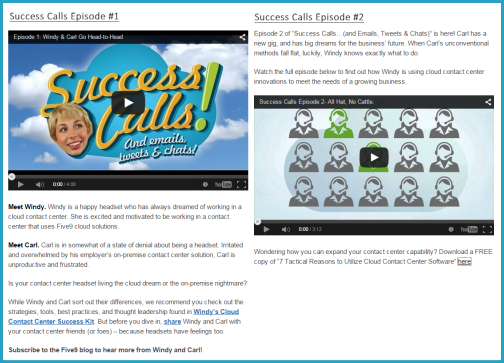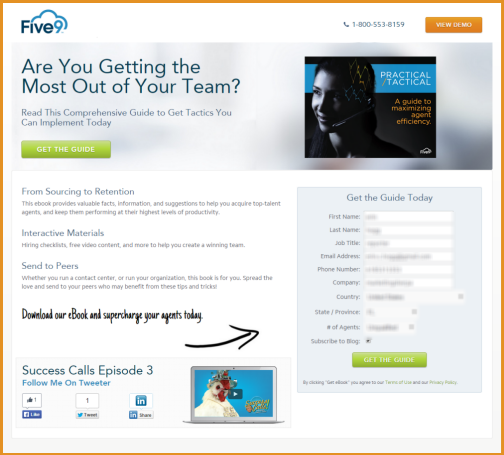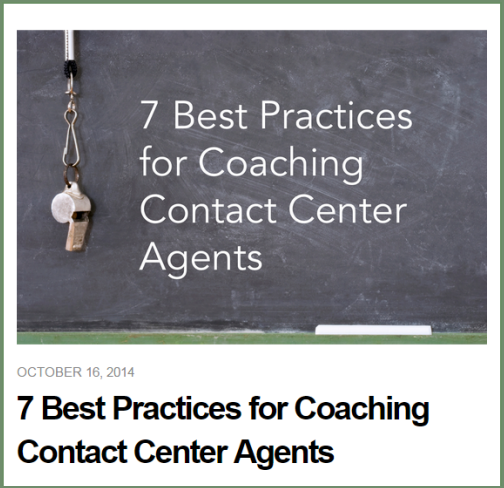by
Erin Hogg, Reporter
Five9, a provider of cloud contact center software, competes with major companies like Avaya, Cisco and Aspect, as well as other well-known cloud-based companies.
With more than 2,000 customers worldwide, the company has 3 billion customer interactions facilitated through its software annually.
Pat Oldenburg, Senior Manager of Content Marketing, Five9, joined the team in November 2012 and worked to better Five9's search engine marketing presence.
In May 2014, he was brought on to a new role at Five9 that was an entirely new operation at the company: content marketing.
CHALLENGE
Oldenburg's team had just begun developing original content and started this process by producing and promoting two videos in a series titled "Success Calls."
The videos were clever but more oriented toward detailing the benefits of Five9's products. Despite the time and money invested, the videos stopped producing leads and engagement in less than three weeks.
Once the promotion budget fizzled out, the ROI died off. The campaign was also missing a key element: collaboration in the marketing department.
"We were creating a lot of product and feature-specific pieces, but what we noticed [was] that we weren’t getting a lot of collaboration within Marketing," Oldenburg said.
Early in 2014, Five9's Chief Marketing Officer told Oldenburg and the team they needed to work on an integrated campaign to get more synergy between the departments, creating more qualified leads to hand off to Sales.
CAMPAIGN
Not many leads were created in the first
two video episodes, and that was a driving force for placing Oldenburg in a content role. New visitors were coming to the site, but it was an expensive effort to not generate many new leads.

Click here to see the full version of this creative sample
Oldenburg was brought on because Five9's team members in different departments were still working toward their own specific goals, even though these campaigns were integrated into a lead generation and nurture cycle.
"There wasn't really one person that was setting the direction and measuring across the different channels, trying to maximize the value of what we were doing," he said.
They needed a new approach for the third and final installment of the video campaign to promote the e-book download.
After seeing the low performance of two video campaigns, Oldenburg and the team decided their next initiative would be a content pillar anchored with the launch of Five9's first buyer-centric e-book, "Practical/Tactical: A Guide to Maximizing Agent Efficiency."
With the first two videos launched in February and April, respectively, the team changed directions for this third episode and launched in September.
The third installment ended with a call-to-action to download the agent efficiency e-book.
THE CUSTOMER
Five9 caters to customers of various sizes, involving two different sales organizations that service the two major customer groupings: SMB (Server Message Block) and enterprise.
The team classifies SMB as under 50 licenses and enterprise as more than 50 licenses. In 2014, in conjunction with the content marketing effort, the team developed several customer personas to target their audience. These customer personas include:
- Contact center and IT managers
- CEOs, who often hold final approval
- Small business owners
- CIOs (Chief Information Officers), who work closely with IT managers
- Informal contact centers, such as inside sales or business development groups
- Sales directors
- Vice presidents of customer service and support
The customer service and support persona was created because they are trying to meet customers wherever they are, whether it be on social media, through a live chat or on the site, and even through SMS and email. The vice president of customer support is a primary buyer for those multichannel contact center applications.
Five9 does not have industry-specific solutions, and Oldenburg aims to keep the personas as industry-agnostic as possible.
Step #1. Develop personas
In creating a content marketing campaign to speak to Five9's audience, Oldenburg set out to create a set of personas (defined in THE CUSTOMER section above) to better target messaging to individuals in an organization.
To start developing these personas, Oldenburg and the team interviewed customers in-person to learn how they were using Five9's solution, what was the need that led them to search for a solution and what improvements they expect out of a solution.
The team performed demographic research on leads as well as closed deals to uncover data, such as the industry, the title and the company size, with the goal of better understanding Five9's base.
Finally, the team employed an email survey to the solution's install base and through a media outlet to generate insights the team could use. This media outlet, ICMI (International Customer Management Institute), disseminated the survey to its audience of professionals.
The survey included questions like:
- Who is the primary driver of the research and evaluations of vendors?
- Who was the final approver of the vendor selection?
- What is your company size?
- What kind of contact center do you have?
- Do you have a customer service or inbound contact center?
- Do you have a telemarketing or an outbound contact center?
- What are your biggest pain points?
The survey asked for respondents' biggest pain point, and based on the survey's results, improving agent efficiency was the highest scoring challenge.
"We hadn't ever created anything that was similar to this, and it was a big pain point of our buyers," Oldenburg said.
Surprisingly, there was no built-in incentive for respondents to offer their opinions.
"We just wrote, 'We want to be able to create content that's educational, interesting and will be of value to you in the future. We'd really like your opinion,'" he added.
Oldenburg attributed that the success of having a substantial number of respondents was a result of Five9's efforts to not overwhelm customers with emails.
Step #2. Create an e-book
After the survey launched in June 2014, Oldenburg acted quickly to cull insights and start writing the
e-book in July.
With a limited budget for content marketing, and because it was such a new function, Oldenburg took on the writing responsibilities himself.
The first draft was completed by conducting research online, looking beyond the contact center industry and discovering insights to share in the e-book on management techniques for improving team performance. After researching and outlining for a couple of weeks, Oldenburg wrote the e-book in one week.
Once the initial writing phase was complete, Oldenburg passed the copy to Five9's corporate writer for editing for consistency as well as to create interactive elements such as checklists, sidebars and videos. By mid-August,
the e-book was complete.

Click here to see the full version of this creative sample
Concurrently during this time, Oldenburg worked with the marketing team to execute a plan to transform the e-book into various derivative assets.
"We had a whole social plan. We had a blog plan, where we had 10 blog posts total and several social posts for each of those. We also turned it into a nurture campaign," Oldenburg said.
Step #3. Repurpose content in blog
The e-book was divided into nine sections, which were broken out and shared through nine blog posts (plus two additional posts featuring a trailer and full version of "Success Calls" episode 3). These topics for blog posts, in coordination with the e-book's sections, included:
- Why agent efficiency matters
- How to hire top-performing agents
- How to onboard new agents
- How to coach agents for maximum success
- How to schedule for maximum effectiveness
- How to reward agents
- How to be there for customers, wherever they are
- How to optimize quality and efficiency
"The blog posts were meant to be really educational, not pushing our product. It really was an effort to provide something of value to our target audiences," Oldenburg said.
To promote each blog post, the team pushed
two social posts to drive traffic to the posts.
By repurposing the e-book content into
more organic blog posts, the team saw these posts had up to three times as many shares per post, compared to other posts written in the past.

Click here to see the full version of this creative sample
"I think people were more willing to share and retweet all of that with something that wasn't necessarily pushing our product," he added.
This effort and success led to a new way for the team at Five9 to think about the company blog. It began as an outlet for corporate news, including news releases and product updates.
This evolved to more topical posts after Five9 acquired a company that was doing a similar practice but wasn't tailoring to personas. Now, the blog is at the stage where the team is becoming more frequent with posts and more targeted.
Currently, a team member in corporate communications at Five9 is writing posts. Oldenburg explained that writing posts repurposed from this e-book, for example, was easy, and she could produce much more content based on the large deliverable of the e-book.
"The next step will be to have people across the organization, whether its engineers writing to the IT manager persona, or professional services writing topics that are interesting to the contact center manager, or an executive blog," he explained.
In an effort to drive more people to the e-book, a call-to-action is included in the posts to entice readers to read more from the full e-book.
Step #4. Post on social media
Five9 leverages LinkedIn, Twitter, Facebook and Google+ to reach prospects and its client base.
According to Oldenburg, LinkedIn is the most powerful platform for the company because it allows the team to dive deep into targeting.
For the e-book, Oldenburg "had very specific targeting for the titles we wanted to hit with these. Some of the LinkedIn posts are very specific to Sales," he said.
However, for Facebook, he explained the company has not currently invested in advertising and posts more general content, not specifically targeted. For Five9, Facebook has not proved to be as much as a viable channel for its audiences as compared to LinkedIn and Twitter, which have targeted messaging.
Five9's Google+ efforts are similar to Facebook and involve sharing more general content.
Step #5. Content for lead nurture
Oldenburg took the finished e-book content, and including sharing it through the blog and social, the content was ultimately repurposed 63 different ways, including the main product (the e-book) and its landing page.
This included:
- 11 blog posts
- 33 social posts
- 2 e-book downloads
- 9 assets in the nurture campaign (9 guides with 9 landing pages and emails)
- 6 emails
To ensure that the content was delivered to the right prospect at the right stage, the content repurposing spanned the entire sales funnel, aiming to meet the needs of Five9's personas at every step of the conversion process.
Oldenburg hit the awareness phase prospects with the video, which was the third part of the "Success Calls" series.
"Even if they don't realize they need a contact center solution and they see the video, they might be interested in downloading the e-book," he added.
Then, the team at Five9 addressed early stage sales cycles with blog and social posts, driving more engagement with Five9's resources to become more educated on call center success and getting to know Five9 better in terms of solutions and capabilities.
For those deeper in the funnel, and now interested in a contact center solution, the marketing team employed email campaigns to further nurture prospects into clients by sharing content from the e-book.
"We ran email campaigns to our house lists, our marketing queue, our in-process opportunities and then through various content syndication methods," he said.
Post-sale to prospects turned into customers, Five9 has sent the e-book to its primary contacts in its current install base, which consists of contact center managers and IT managers.
"I think we're spanning the sales cycle with this. That was kind of the goal, to create something that we could repurpose effectively to hit all of the different stages in the funnel for our customers and prospects," Oldenburg said.
RESULTS
In the first month since launching the e-book and content repurposing effort, the team began to reap its benefits.
The e-book drove four times as many leads compared to Five9's previous efforts and lifted closed deals threefold.
On a more qualitative level, lead development reps reported some of the best prospect conversations they ever had.
With this transformation to truly using content as a pillar for lead generation and nurturing, the strategy went from an intriguing experiment to an entrenched strategy within the company's marketing.
"We had never really done a cohesive marketing campaign like this. Without having an anchor, a base piece of content, I can't even imagine how we would have created a strategy or have been able to work one asset off another and drive the efficiency that we did when we created the e-book," Oldenburg said.
Oldenburg recommended to focus on one asset and use it to create smaller, different pieces based on it.
"It was an easy way to wrap all our heads around how to do this. It also made the planning the workflow much more predictable," he explained.
One big lesson Oldenburg and the team learned was the difference between leading with a channel and leading with content. For the first two videos in the series, the team lead with the channel — video. This was the focus, and the less-than-stellar results reflected that this strategy was not working to generate leads.
"When we led with content, we were able to focus on that and then work on the channels and get the strategy down effectively," he said.
In the future, Oldenburg explained that the team will continue surveying its audience to create quarterly content themes to build a content pillar.
Then, the team will strive to position the Five9 blog as a hub and target personas through that content channel.
"We're going to start writing to our personas on a more consistent basis and start using our blog to drive, not even lead gen, but make it kind of a hub for content and informational and valuable things for all of our personas," he concluded.
Creative Samples
- First two video episodes
- Third episode with customer-centric e-book
- E-book download
- Social post
- Repurposed blog post
Sources
Five9KapostRelated Resources
B2B Content Marketing: 100% increase in lead gen for customer service software companyB2B Content Marketing: Software company increases list 130% with content curationB2B Content Marketing: 60% lift in site traffic from embracing an inbound strategyContent Marketing: Consulting firm nets 388% more leads with 4-step strategy












